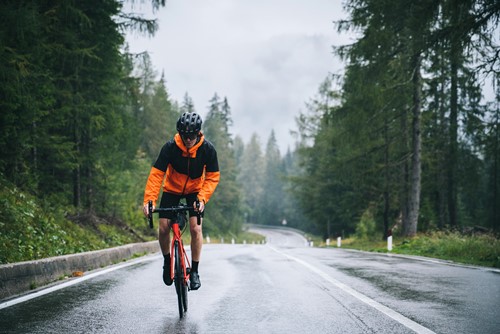Essential tips for cycling in the rain
05 October 2017

The downside of living in the UK is that you can face cycling in the rain throughout the year, but you don’t want to shelve your bike every time it rains, especially if you rely on your bike for your daily commute.
That’s why we’ve listed our top 5 tips for staying as dry and safe as possible when cycling in the rain.
1. Wear waterproof clothing
For heavy or persistent rain, a waterproof jacket, overshoes, and gloves with as much water resistance as possible will help you battle the elements. The key to finding the right waterproof clothing for cyclists is that it not only keeps you dry but also gives you the necessary breathability for your body heat to escape. Gore-Tex is often considered the best material for those cycling in the rain, as it’s waterproof and breathable.
Vented helmets are great when the weather’s warm and dry, but when cycling in the rain, they can mean your head gets wet. A cycling cap worn under your helmet is a good barrier for your head and hair and also provides extra protection for your eyes with the cap’s peak against the pouring rain.
2. Use mudguards
We admit, mudguards might not be the most fashionable cycling accessory, but they are vital for cycling in the rain. They will help keep you, your kit, and the cyclists behind you clean.
Unfortunately, without mudguards, you risk permanently staining jerseys and jackets with oil, mud, and other substances. Even if you manage to miss the rain before your ride, the roads will remain wet—so make sure you invest in one!
3. Avoid standing water
Riding through standing water not only gets you wet, it can be extremely dangerous as you never know what’s hiding underneath. It might seem like just a puddle, but it could be hiding a bike-damaging pothole.
Most standing water will gather near the kerb, so check over your shoulder for vehicles before moving away from the kerb to avoid the area. When cycling in the rain, only ride through standing water if you can clearly see what’s beneath it.
Make sure to try and avoid any rainbow-edged patches on the street, too—they can be a strong indication of an oil patch. Also, keep an eye out for other slippery surfaces when wet, such as manhole covers and damp leaves.
4. Check your tyres
When cycling in the rain, tyre grip becomes even more important. After each ride, make sure to look over your tyres for any flints, glass, or other debris. The wet weather makes it easier for these materials to damage your tyres.
It’s also a good idea to ride the heavier tyre in the winter with a thick tread, as this will give you more grip for both a wet road and icy road. A 25 – 28c tyre with a slightly lower pressure should give you the grip you need, even in the worst of conditions.
Specialist cycling insurance through Cycleplan
Before you head out on your next ride (whether in rain or fairer weather), you may want to consider getting specialist cycling insurance through Cycleplan.
This protects you if your bike is lost, damaged or stolen, providing you report it to the police within 24 hours.
At Cycleplan, we arrange equipment cover for a range of bikes up to a total value of £30,000. We also offer additional policies such as public liability and personal accident cover.
Find out more about specialist cycling insurance or get a quick online quote today.
Please note the information provided on this page should not be taken as advice and has been written as a matter of opinion. For more on insurance cover and policy wording, see our homepage.
